After a cold, dark winter, many of us long for the warmth and radiance of high summer, as well as the sights, smells and sounds of nature that go with it. And we wouldn’t be alone, for it is eagerly awaited by a huge number of insect species too. Spring’s sudden burgeoning lushness signposts the way for peak vegetation in June and July, as trees maximise their leaf-load and woodlands become shadier under the dense canopies. But while this may create cool oases for mammals and birds it isn’t such a hotbed for insect life; for this we need to venture out into another habitat that is currently exploding with growth – the grasslands.
Gorgeous Grasslands
© Gail Ashton

(c) Terry Whittaker/2020VISION
Grasslands are large, open areas that are dominated by grasses and herbaceous plants. Soil nutrients are typically low, and the absence of tree cover allows a wide variety of wildflower species, such as Southern Marsh Orchid, Meadow Saxifrage, Meadowsweet and Pasque flower to thrive which, in turn, attract their own specialist pollinators. Grasslands are also incredibly effective carbon sinks (considered as important as forests) because they remove CO2 from the atmosphere and capture the ground for long periods of time.
In our area we are extremely lucky to have some very special grassland habitats that are managed and protected by the Trust, such as Frogmore Meadow, Blagrove Common and Hexton Chalk Pit. Over the past few years, the Hertfordshire Invertebrate Project has recorded a number of grassland species for the first ever time in the county. In 2019 the Fan-bristled Robberfly (Dysmachus trigonus) was discovered in King's Meads, near Ware and the first record of the Down Shieldbug (Canthophorus impressus) was taken in Therfield Heath. In 2021 a rare chafer, Omaloplia ruricola, was recorded for the first time since 1892 and only the second time in Hertfordshire. These exciting discoveries show just how much there is yet to discover, how important our local grasslands are for biodiversity where we live, and why it is so critical that we protect them.
You can expect to see a wide range of insect families in grassland habitat, from soil level, right up to the tallest tips of grass blades. Here are just a few of the highlights of our summer grasslands:
SHIELDBUGS
Summer is the domain of the shieldbugs, and many of the UK’s 43 species can be found in grasslands. They are characteristically ovoid, or shield-shaped, and though they can look superficially like beetles, shieldbugs have a few features that distinguish them. One is the long, rigid feeding tube (rostrum) that is stowed underneath the body, and another is the partially visible wings at the end of the body (confusingly though, not visible in some shieldbugs). Shieldbugs also have fewer antennal segments – three to five, depending on their growth stage.

© Gail Ashton
One of our most distinctive grassland shieldbugs is the Bishop’s Mitre Shieldbug (Aelia acuminata), named for its striking similarity to – yes, you guessed it – the pointy hat that sits atop the eponymous, high-ranking clergyperson of the Church of England. It is elegant in demeanour, straw-coloured with a pointed face and long, dotted bands running from ‘nose’ to tip. This fabulous shieldbug is widespread in southern parts, in fields and meadows with long grass and lots of sunshine where it will perch on umbellifer heads or on tall grass stems.
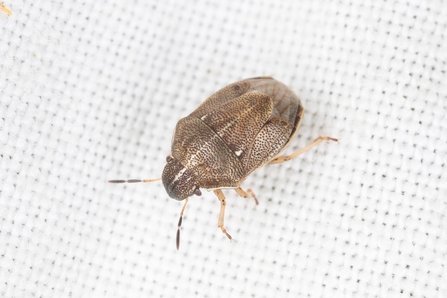
© Gail Ashton
Another, more elusive, species is the Small Grass Shieldbug (Neottiglossa pusilla). This tiny bug, just 5-6mm in length, is much more difficult to spot than its larger relatives and its plain, brown colouring gives it outstanding camouflage, but is one of our most exciting species to find, due to its relative scarcity.

© Gail Ashton
Delve a little deeper into the grass and you may spot one of our showiest shieldbugs – the Blue Shieldbug (Zicrona caerulae). It is electric blue, or green, depending on which way the light bounces off its highly metallic surface, and for good reason. Blue Shieldbugs are carnivores and their prey – Altica sp. leaf beetles – are also metallic blue-green. It is likely that Blue Shieldbugs have evolved to look like their prey so that they can hide in plain sight and pick off unsuspecting prey. Interestingly, Blue Shieldbug nymphs are bright red; maybe this is to avoid being eaten by their own parents?!...
DAY FLYING MOTHS
We are all familiar with the appearance of butterflies in our summer meadows, but what about their nocturnal relatives, the moths, who also emerge en masse in the summer months? The UK has around 130 moth species which are diurnal (meaning they come out in the day) and, unsurprisingly, can be mistaken for butterflies because of this.
One of our most stunning day-flying grassland moths is the burnet moth, of which there are eight UK species. The Six-spot Burnet is a common species that can be found flitting purposefully around, nectaring on various meadow flowers such as trefoils and vetches. It will often congregate in numbers on thistle flower heads, with glossy black and crimson wings catching the light softly.
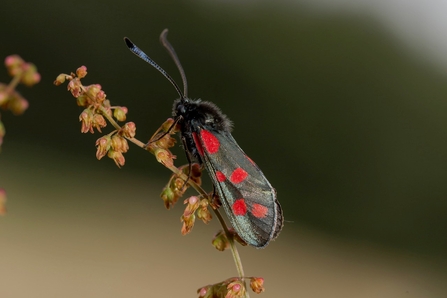
© Gail Ashton
The Mother Shipton is also highly distinctive, although at a glance it could be mistaken for a Dingy or Grizzled Skipper. Look closer, though and you will see a peculiar outline, mirrored on each forewing. It is said to resemble the facial profile of Mother Shipton, a 16th century witch who resided in Yorkshire. I find both her being labelled as a witch, and her visual portrayal as an old crone rather unkind, but it does make for a memorable diagnostic feature.

© Gail Ashton
One of our tinier diurnal moths is also the most bonkers. The Yellow-barred Longhorn (Nemophora degeerella) is a stunning micro moth (one of around 1500 UK species) with a striking yellow band across its wings. The males have truly enormous antennae, many times longer than their own body length, which they use to gather information from the air, including whereabouts of females.
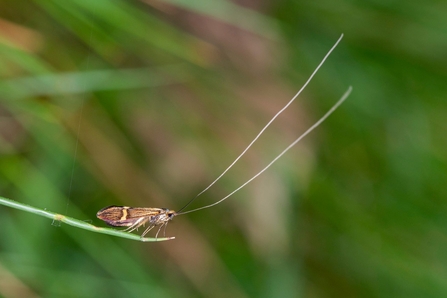
© Gail Ashton
SOLDIERFLIES:
Grasslands are the perfect habitat for flies, who love hot, sunny, open areas in which to maintain their body temperature, and forage on the large umbellifer heads which grow there. Soldierflies are particularly attractive flies which can be found in summer grasslands, particularly near water or in wet meadows, as the larvae are aquatic.
Soldierflies are so named because some of them have bold colouration which is said to resemble military uniform, and many of the species common names also reflect this. The Banded General (Stratiomys potamida) is a beautiful soldierfly; it has a black thorax and crisp yellow markings on its abdomen. It has a pair of formidable-looking spines on its back, and rather stout antennae, which help to distinguish it from the hoverflies.

© Gail Ashton
Less stripey than the Banded General, but way shinier, is the Broad Centurion, an extremely common soldierfly that can be found in grasslands, and also gardens if you have wilder patches of long grass. This species is sexually dimorphic; the male (pictured) has a bronze abdomen, whereas the female’s is blue.
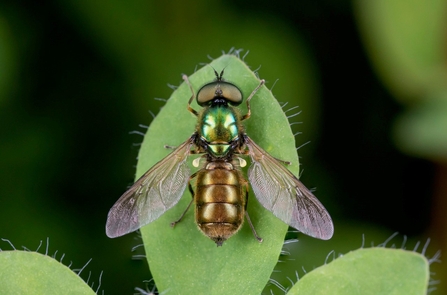
© Gail Ashton
GRASHOPPERS AND BUSH CRICKETS
What grassland would be complete without the quintessence of summer – the grasshoppers? These agile insects are long grass specialists and there can be no greater sound in summer, than to hear them chirruping away as they stridulate in the vegetation. The Mottled Grasshopper (Myrmeleotettix maculatus) is a common and widespread species which prefers dry grassland. It has distinctive antennae which are clubbed (they get wider at the tips) which makes it easy to distinguish it from most other grasshopper species.
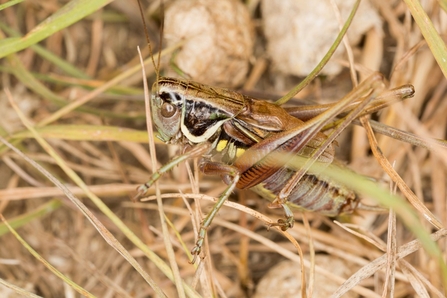
© Gail Ashton
The Meadow Grasshopper (Chorthippus parallelus) can be found nearly everywhere in the UK in a variety of grassland habitats. Like other grasshoppers, it is difficult to spot in early summer as the newly emerged nymphs are teeny. However, by mid-July they have moulted several times and are large enough to be seen leaping around your feet as you walk along meadow paths. It is usually bright green, though it can often be found in a fabulous, bright pink colour form.
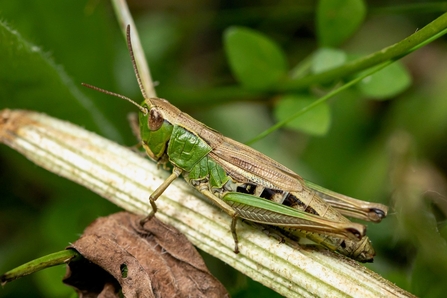
© Gail Ashton
Our last grassland superstar is a relative newcomer to most of the UK. Confined to a tiny area of the South-east until the mid-20th century Roesel’s Bush Cricket (Metrioptera roeselii) is now expanding at some pace throughout the south of England and is widespread throughout Hertfordshire and Middlesex. It has the long, slender antennae that are characteristic of bush-crickets, and a crisp, pale horseshoe-shaped band on the sides of the pronotum that is unique to this stunning species.

© Gail Ashton
So now you know a little bit more about our incredible grassland species, why not pick one of the Trust's beautiful reserves to visit and have a look for them? From the biggest dragonflies to the tiniest flies, you can see so much insect life in our marvellous meadows, so get out there and see for yourself!
Gail Ashton is a nature writer, photographer and artist specialising in terrestrial invertebrates. Her first book, ‘An Identification Guide to Garden Insects of Britain and North-west Europe’, co-written with Dominic Couzens, is available now at all major in-store and online retailers.
When out in summer grasslands, remember to take plenty of water, wear a wide-brimmed hat and apply lots of sunscreen, because open grasslands get really hot in summer. Also, cover up with light, long clothing and proper footwear, and apply insect repellent, to keep at bay those little meadow residents that rather like the taste of blood, such as ticks and horseflies. And do please keep your dogs on a lead, so that nesting and roosting animals are not disturbed.

